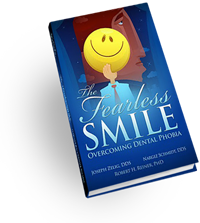
An excerpt written by Dr. Reiner from The Fearless Smile Overcoming Dental Phobia
Robert H. Reiner, PhD
Nargiz Schmidt, DDS
Joseph Zelig, DDS
Understanding Phobias
In order to fully understand the dynamics of dental fear, it is important to know the basic characteristics of fear and anxiety in general terms. All phobias, fears, and anxieties have a unifying commonality and pattern.
What Is an Anxiety?
An anxiety is a difficult uneasiness in the mind, usually relating to an impending or anticipated event that is perceived as negative.
What Is a Phobia?
A phobia is a persistent, irrational fear of a specific object, activity, or situation that leads to compelling desire to avoid it.
Veronica’s Story
How Phobia Nearly Ruined a Career
Veronica was a successful New York City attorney with degrees from Ivy-League schools. She had suffered from fear of flying since she was a child and hadn’t flown for years. Like most people with phobias, no matter how hard she tried, her problem seemed to get worse as she got older. Veronica had an excellent record as a trial lawyer and won twice in appellate court making her almost a celebrity within the firm. Nonetheless, she had been passed over for partner by her law firm because her flying phobia made it so she couldn’t travel to see the firm’s corporate clients.
Veronica wanted to advance her career so badly that she decided to take things into her own hands. Instead of going in for treatment for her phobia or starting slowly with a short flight, she flew to California to visit one of her bigger clients who had complained of her “unwillingness” to fly. After about an hour into the cross-country flight, her anxiety accelerated and she began to emotionally unravel. She became increasingly agitated and couldn’t stop fixating on two overweight women in front of her, both seated on the right side of the plane’s cabin. Drained of any remaining self-control, she stood up and screamed, “You girls are really fat! I want one of you to get off your fat butt and sit on the other side of the aisle so the plane is balanced and won’t tip over.” Naturally, they refused.
In her state of panic, she ran towards the door of the plane yelling that she was going to jump out. Although it is impossible for the door of an airborne commercial jet to be opened from the inside by a passenger, Veronica was tackled and restrained by several passengers and flight attendants. At this point, she was fully hysterical. Unable to keep her under control they put her in a strait jacket. One of the worst things possible for a person in her condition! When she wouldn’t stop screaming, they gagged her.
When they finally landed in California, federal marshals came on the plane and led her away in handcuffs. Several days later, she took a train back to New York and, after finally admitting to herself that she had a problem she could not fix by herself, she began treatment for fear of flying. The clinical psychologist who treated her diagnosed her with extreme aviophobia (fear of flying) in combination with claustrophobia (fear of being in closed places).
After identifying Veronica’s problem, her therapist was able to come up with a treatment plan, combining biofeedback with virtual reality therapy. She learned how to breathe in a way that would lead to relaxation (slow abdominal breathing) and could practice in a safe environment (a virtual airplane) before embarking on an actual airline flight. When she was ready to fly, her doctor encouraged her to take it slowly and begin with a short trip from La Guardia to Syracuse, eventually building up to longer flights. Now, Veronica is flying all over the country to meet with her clients. She was finally named partner at her law firm and was able to take a celebratory and long-awaited vacation in Europe.
Phobias are irrational fears about objects, people or situations. Phobias, along with obsessive compulsive disorders and addictions, have a tendency to be progressive in nature. Therefore, if left untreated, they usually worsen over time. There is no rhyme or reason as to how and why phobias develop and there is rarely, if ever, a single identifiable cause. Almost everyone experiences occasional bouts of anxiety in the absence of a realistic threat, but what makes phobic behavior distinct is that irrational fears and concerns begin to govern important decisions, eventually becoming disruptive to the lives of the individual and those close to him. In retrospect, many phobic patients can recall this point of disruption, often referring to it as a time when they “crossed over”; a point in which the phobia begins to dominate a person’s thoughts and behaviors, taking on almost obsessional characteristics.
Phobias have absolutely nothing to do with intelligence. They are not about reasoning or facts, but are a physical reaction to anxiety. One of the things that leads to a great deal of frustration is that while a phobic person is usually aware that their fear is unreasonable, it is impossible for them to overcome the fear or confront the situation in a reasonable manner. For this reason, telling them that there is nothing to be afraid of will only be detrimental to their state and probably leave the person feeling even more alienated and misunderstood.
As an example, almost all people who have a fear of flying have heard the same statistic: the automobile ride to the airport is far more dangerous than the flight. Because phobias are not related to intelligence or rational understanding, this sort of reasoning is useless and often insulting.
Similarly, reminding a person who has avoided the dentist for a decade that not going for regular cleanings every six months will result in poor dental hygiene and tooth decay will not be helpful advice. The phobic patient certainly knows this and only wishes he were capable of sticking to such a regimen. The problem with phobic behavior is that the ability to think and reason rationally dissolves once the individual is faced with the feared situation and is instantly replaced by dread or raw panic.
Despite this intense feeling of dread and panic, most people never seek help for their debilitating fears. Frequently, people will put off getting help for numerous reasons, which are usually as unrealistic and exaggerated as the phobia itself.
This avoidance is often due to embarrassment the phobia alone. This is referred to as “symptoms preventing treatment.” People generally have psychological “blind spots” when it comes to seeing themselves objectively, honestly or as others see them, or concern about being ridiculed. The person may have difficulty admitting weakness and feel more comfortable trying to overcome things alone.
Phobias typically worsen over time when people behave protectively. This can result in an inability to lead a normal existence and eventually progress to where unrealistic fears control a person’s feelings, thoughts and behaviors. For instance, a fear of elevators may prevent a person from taking a job; a fear of having a panic attack on the street may prevent a person from leaving their home; and a fear of the dentist often leads to a patient avoiding the dentist altogether; resulting in mounting dental problems that could become painful, embarrassing and unhealthy.
Fight or Flight
Phobias are actually the body’s physical reaction to irrationally perceived danger. The body’s normal reaction to danger is known as the “fight or flight” response and is directly linked to self-preservation. When this response is activated you have two options: either stay put and face the danger lurking, or run away in order to avoid confronting the feared situation.
When the body senses fear, muscles naturally tighten and function almost like a suit of armor in an effort to protect vital organs. Blood pressure, respiration and heart rate soar, quickly delivering oxygenated blood to the body’s large muscles. Blood flow is temporarily shunted away from the peripheral areas (hands, feet and face) and circulates where it is needed (heart, lungs and other vital organs). This is why when a person is afraid, their hands and feet often become cold and the face can become pale. Hence the statements, “cold hands warm heart,” “you look like you’ve seen a ghost” and “I have cold feet” really do make sense biologically.
The body’s physical response to fear dates back to prehistoric times when survival was linked directly to a person’s ability to protect himself from the dangers posed by the environment. In early civilizations, the person who was able to react quickly to cues that a saber tooth tiger was in proximity was certainly more likely to survive than the person who snoozed even slightly. This is the basis for Darwin’s theory of natural selection or “survival of the fittest” and explains many of the traits that have been carried forward to modern-day man. Concerns about the consequences of not making a mortgage payment may trigger the same warning system as those worries that our ancestors had about becoming prey to saber tooth tigers during prehistoric times. While environmental and emotional concerns have changed throughout history, our tightly wound autonomic nervous systems have always responded to perceived threats in pretty much the same way.
It is only over the past 300-400 years that people living in North America could generally sit around in a relaxed way without any major environmental threat. Given that human beings have walked the earth for hundreds of thousands of years, it is not surprising that we have inherited the brains of our most alert and vigilant ancestors. Ironically, what kept our ancestors alive has evolved beyond usefulness, and now presents disadvantages.
When a person senses some sort of threat, they not only becomes emotionally aware of impending danger (anxiety), but their body becomes prepared as well. Although in prehistoric times this almost always worked in man’s favor, such an extreme reaction to modern- day fears is not always beneficial. Frequent bouts of increased respiration, blood pressure and heart rate put undue strain on the body’s systems which may result in serious health problems. This can also lead to protective behavior and ultimately, avoidance. If you live in a city and every time you hear a loud noise your “fight or flight” response is activated, you will certainly waste vital resources by adopting a defensive psychological posture or mindset. Being thin-skinned or having a short fuse is not a relaxing way to live a life.
Fortunately, strategies have been developed to manage stress and anxiety. While it is natural to be afraid, it is possible to change the way we react to things in our environment that may scare us, but do not present actual threats.


